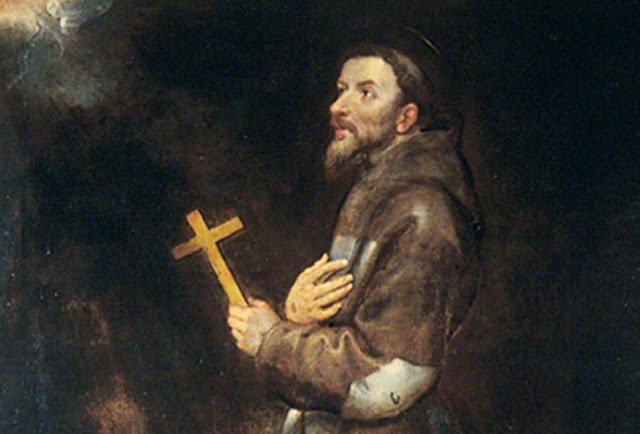Saint Francis of Assisi by Herrera I the elder
Español
Francisco Herrera the Elder (c. 1590–1656) was a Spanish painter and engraver whose work marks the transition from late Mannerism to Baroque in Seville. Born into a family of artists, Herrera trained under his father, Juan de Herrera y Aguilar, and may have briefly studied with Francisco Pacheco. Known for his strong personality and frequent legal disputes, Herrera nonetheless gained early recognition for his skill in both oil painting and engraving. His earliest known works include an engraved book cover (1609) and a painting of the Pentecost (1617).
Herrera’s career flourished in Seville during the 1620s and 1630s, when he received major commissions for churches and convents, including the decoration of the Franciscan College of San Buenaventura. His style evolved from the linear precision of early illumination and Mannerist composition toward a freer, more expressive technique influenced by Juan de Roelas. This allowed Herrera to combine loose brushwork with bold Venetian-inspired color, producing works that balanced structural compositional schemes with dynamic energy and vibrant tonalities.
He is also noted for his brief mentorship of Diego Velázquez, although Herrera himself was not a revolutionary stylist. While his early works retained Mannerist elements, later paintings, including the series on the life of St. Bonaventure, reflect a shift toward naturalism influenced by Francisco de Zurbarán and the broader Spanish Baroque tradition. Herrera’s mature works often exhibit broad, energetic brushwork, a strong modeling of figures, and dramatic, expressive use of light and shadow.
After moving to Madrid around 1638, Herrera’s style continued to evolve, showing traces of influence from Anthony van Dyck in his later compositions, such as St. Joseph (1648). Despite not fully adopting the innovations of Velázquez and other court painters, Herrera enjoyed widespread fame in his lifetime, influencing subsequent Spanish artists, including Bartolomé Esteban Murillo, who drew inspiration from Herrera’s Miracle of the Loaves and Fishes. His career exemplifies the dynamic interplay between tradition and innovation in 17th-century Spanish painting.
Herrera the Elder’s painting of Saint Francis Holding a Crucifix exemplifies his mature Baroque style and reflects the saint’s intense religious devotion and meditative state. St. Francis is shown in his traditional brown Franciscan habit, tied with the three-knotted rope cincture, and portrayed as a mature, bearded man. He holds or meditates before a wooden crucifix, symbolizing both his devotion to Christ’s sacrifice and his mission to rebuild the Church.
The saint’s upward gaze and composed posture convey a profound spiritual connection, while the simple setting emphasizes private devotion. Herrera’s energetic brushwork and strong modeling give the figure a relief-like presence, a striking contrast to the more timid styles of his contemporaries. Occasionally, a skull may appear as a memento mori, reminding viewers of mortality and the necessity of contemplation, though the focus remains squarely on the intimate spirituality of St. Francis.





Comments
Post a Comment